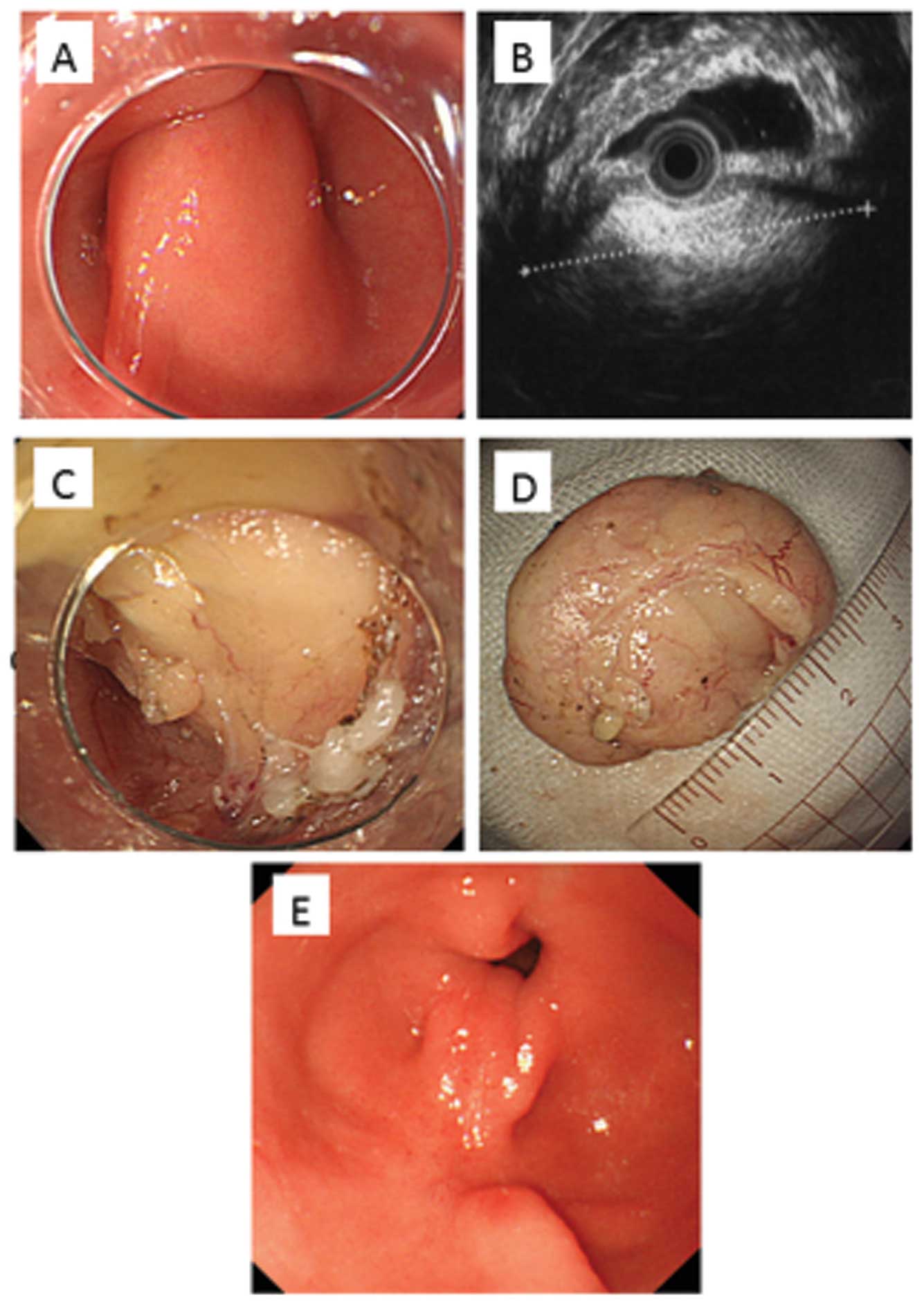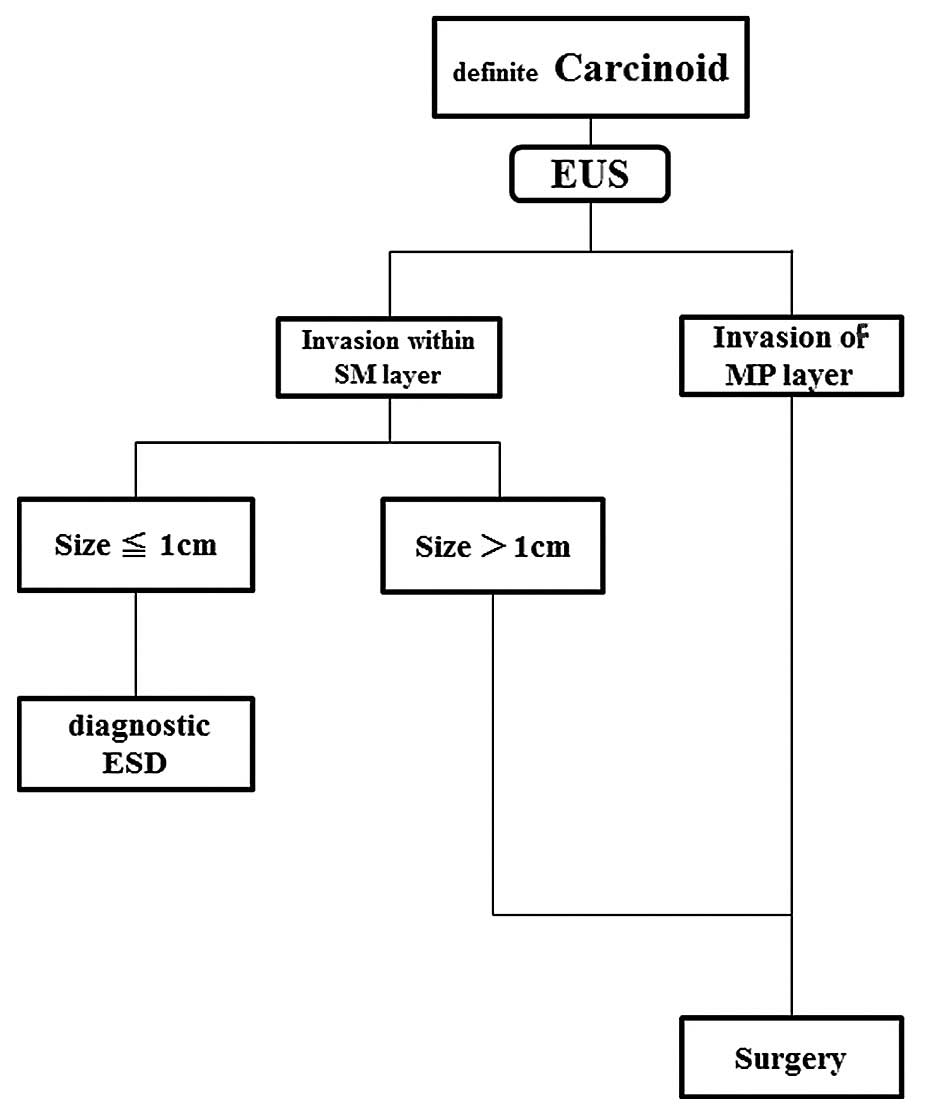|
1.
|
Mazur MT and Clark HB: Gastric stromal
tumors. Reappraisal of histogenesis. Am J Surg Pathol. 7:507–519.
1983. View Article : Google Scholar : PubMed/NCBI
|
|
2.
|
Mori H, Kobara H, Kobayashi M, et al:
Establishment of pure NOTES procedure using a conventional flexible
endoscope: review of six cases of gastric gastrointestinal stromal
tumor. Endoscopy. 43:631–634. 2011. View Article : Google Scholar
|
|
3.
|
von Renteln D, Rosch T, Kratt T, et al:
Endoscopic full-thickness resection of submucosal gastric tumors.
Dig Dis Sci. 57:1298–1303. 2012.PubMed/NCBI
|
|
4.
|
Kobara H, Mori H, Fujihara S, et al: Bloc
biopsy by using submucosal endoscopy with a mucosal flap method for
gastric subepithelial tumor tissue sampling (with video).
Gastrointest Endosc. 77:141–145. 2013. View Article : Google Scholar : PubMed/NCBI
|
|
5.
|
de la Serna-Higuera C, Perez-Miranda M,
Diez-Redondo P, et al: EUS-guided single-incision needle-knife
biopsy: description and results of a new method for tissue sampling
of subepithelial GI tumors (with video). Gastrointest Endosc.
74:672–676. 2011.PubMed/NCBI
|
|
6.
|
Ono H, Kondo H, Gotoda T, et al:
Endoscopic mucosal resection for treatment of early gastric cancer.
Gut. 48:225–229. 2001. View Article : Google Scholar : PubMed/NCBI
|
|
7.
|
Katoh T, Itoh Y, Mohri T, et al:
Endoscopic enucleation of gastrointestinal stromal tumors of the
stomach: report of five cases. World J Gastroenterol. 14:2609–2611.
2008. View Article : Google Scholar : PubMed/NCBI
|
|
8.
|
Bialek A, Wiechowska-Kozlowska A,
Pertklewicz J, et al: Endoscopic submucosal dissection for
treatment of gastric subepithelial tumors (with video).
Gastrointest Endosc. 75:276–286. 2012. View Article : Google Scholar : PubMed/NCBI
|
|
9.
|
Rosch T, Sarbia M, Schumacher B, et al:
Attempted endoscopic en bloc resection of mucosal and submucosal
tumors using insulated-tip knives: a pilot series. Endoscopy.
36:788–801. 2004. View Article : Google Scholar : PubMed/NCBI
|
|
10.
|
Bialek A, Wiechowska-Kozlowska A and Huk
J: Endoscopic submucosal dissection of large gastric stromal tumor
arising from muscularis propria. Clin Gastroenterol Hepatol.
8:e119–e120. 2010. View Article : Google Scholar : PubMed/NCBI
|
|
11.
|
Inoue H, Ikeda H, Hosoya T, et al:
Submucosal endoscopic tumor resection for subepithelial tumors in
the esophagus and cardia. Endoscopy. 44:225–230. 2012. View Article : Google Scholar : PubMed/NCBI
|
|
12.
|
Hyun JH, Jeen YT, Chun HJ, et al:
Endoscopic resection of submucosal tumor of the esophagus: results
in 62 patients. Endoscopy. 29:165–170. 1997. View Article : Google Scholar : PubMed/NCBI
|
|
13.
|
Kojima T, Takahashi H, Parra-Blanco A, et
al: Diagnosis of submucosal tumor of the upper GI tract by
endoscopic resection. Gastrointest Endosc. 50:516–522. 1999.
View Article : Google Scholar : PubMed/NCBI
|
|
14.
|
Waxman I, Saitoh Y, Raju GS, et al:
High-frequency probe EUS-assisted endoscopic mucosal resection: a
therapeutic strategy for submucosal tumors of the GI tract.
Gastrointest Endosc. 55:44–49. 2002. View Article : Google Scholar : PubMed/NCBI
|
|
15.
|
Ono A, Fujii T, Saito Y, et al: Endoscopic
submucosal resection of rectal carcinoid tumors with a ligation
device. Gastrointest Endosc. 57:583–587. 2003. View Article : Google Scholar : PubMed/NCBI
|
|
16.
|
Yoshida T, Fujisaki J, Suganuma T, et al:
Successful en bloc resection of a 5 cm symptomatic sessile gastric
lipoma by endoscopic submucosal dissection. Dig Endosc. 24:2822012.
View Article : Google Scholar : PubMed/NCBI
|
|
17.
|
Kobara H, Mori H and Masaki T: Successful
en bloc resection of an esophageal hemangioma by endoscopic
submucosal dissection. Endoscopy. 44(Suppl 2): E134–E135. 2012.
View Article : Google Scholar : PubMed/NCBI
|
|
18.
|
Lee DS, Jeon SW, Park SY, et al: The
feasibility of endoscopic submucosal dissection for rectal
carcinoid tumors: comparison with endoscopic mucosal resection.
Endoscopy. 42:647–651. 2010. View Article : Google Scholar : PubMed/NCBI
|
|
19.
|
Park HW, Byeon JS, Park YS, et al:
Endoscopic submucosal dissection for treatment of rectal carcinoid
tumors. Gastrointest Endosc. 72:143–149. 2010. View Article : Google Scholar : PubMed/NCBI
|
|
20.
|
Urakami T, Kondo K, Kasugai T, et al: A
case of recurrent esophageal cavernous hemangioma increasing
rapidly after surgery. Jpn J Thorac Cardiovasc Surg. 46:1206–1210.
1998.(In Japanese).
|
|
21.
|
Lee IL, Lin PY, Tung SY, et al: Endoscopic
submucosal dissection for the treatment of intraluminal gastric
subepithelial tumors originating from the muscularis propria layer.
Endoscopy. 38:1024–1028. 2006. View Article : Google Scholar
|
|
22.
|
Hwang JC, Kim JH, Kim JH, et al:
Endoscopic resection for the treatment of gastric subepithelial
tumors originated from the muscularis propria layer.
Hepatogastroenterology. 56:1281–1286. 2009.PubMed/NCBI
|
|
23.
|
Park CH, Cheon JH, Kim JO, et al: Criteria
for decision making after endoscopic resection of
well-differentiated rectal carcinoids with regard to potential
lymphatic spread. Endoscopy. 43:790–795. 2011. View Article : Google Scholar
|
|
24.
|
Soga J: Carcinoids of the rectum: an
evaluation of 1,271 reported cases. Surg Today. 27:112–119. 1997.
View Article : Google Scholar
|
|
25.
|
Matsumoto T, Iida M, Suekane H, et al:
Endoscopic ultrasonography in rectal carcinoid tumors: contribution
to selection of therapy. Gastrointest Endosc. 37:539–542. 1991.
View Article : Google Scholar : PubMed/NCBI
|
|
26.
|
Zhou PH, Yao LQ, Qin XY, et al: Advantages
of endoscopic submucosal dissection with needle-knife over
endoscopic mucosal resection for small rectal carcinoid tumors: a
retrospective study. Surg Endosc. 24:2607–2612. 2010. View Article : Google Scholar
|
|
27.
|
Modlin IM, Oberg K, Chung DC, et al:
Gastroenteropancreatic neuroendocrine tumours. Lancet Oncol.
9:61–72. 2008. View Article : Google Scholar
|













